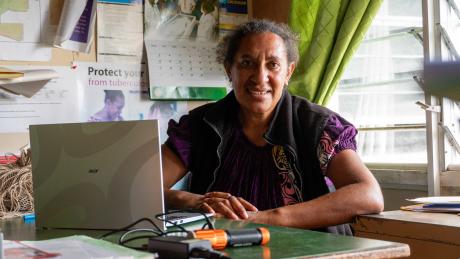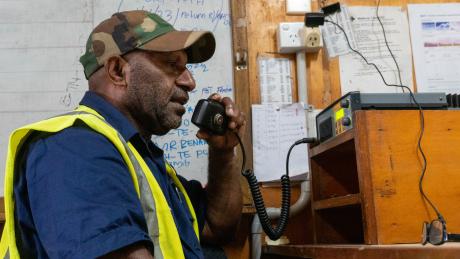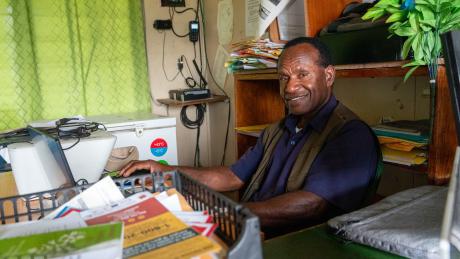
In Papua New Guinea’s Telefomin District, transceiver radios are more than communication tools, they are lifelines. With no roads and patchy mobile coverage, health workers depend on these radios – and MAF – to deliver care and save lives.
Story by Mandy Glass
“If there’s no VHF communication radio here, I think it would be a big, big problem for us. We would be losing lives – so many lives out there,” says Vanessa Yan, District Family Health Services Coordinator in Telefomin.
In the rugged mountains of Telefomin District, where roads are almost non-existent and digital networks often fail, health workers face immense challenges. One tool has become indispensable: the HF/VHF radio.
If a mother delivers and the placenta is retained, it’s via VHF radio that they get in touch with us.
VHF (Very High Frequency) radios are used for short-range, line-of-sight communication, while HF (High Frequency) radios enable long-distance contact across rugged terrain by bouncing signals off the upper atmosphere.
Installed and supported through MAF Technologies, these radios are not only still relevant in today’s world, they are lifesaving.
“Most of the health facilities don’t have any communication network at all. It’s only through VHF radios that I communicate with them,” she said.
Vanessa coordinates maternal and child health programs, arranges supplies, and responds to emergencies in real time.
“If a mother delivers and the placenta is retained, it’s via VHF radio that they get in touch with us,” she said.

Cathy Uniogim, Health Extension Officer and district tuberculosis/HIV officer, agrees. Since she joined the Telefomin District Health Office in 2023, she is managing emergencies, referrals and coordinating health awareness campaigns.
“Especially for clinical communication from outstations, the VHF radio is very useful. Because the radio is there, we are still able to communicate,” she said.
“People from other levels, like local councillors, also use the VHF to share information with their wards. Even the police sometimes come in to use the radio to deal with law-and-order issues in areas without a phone network.
“So, it’s very useful—not just for health, but in all areas where there’s no other way to communicate,” Cathy said.

Sometimes, when the mobile phone network is functioning, villagers hold a phone to the radio mouthpiece to relay messages and extend the information chain as far as possible.
“If we can’t reach a superior, we always communicate with MAF. We know their schedule—2 o’clock is their sched time. We standby to relay emergencies,” Cathy added.
Cathy’s own journey was made possible by MAF flights.
“I don’t think I’d be a health officer today without MAF. It would take days or weeks to walk from one place to another,” she said, referring to the various flights she’s taken since finishing high school, all the way through the various locations of her medical training and placements over the years.
“MAF has been the only means of transport, before I was born, after I was born, and even now. It’s the only transport that has truly been reliable,” Cathy said.
Abel Yangsin, a senior Community Health Worker and Rural Health Supervisor, oversees 19 aid posts. He uses the HF radio for deliveries, patient updates, and mentoring staff.

I don’t think I’d be a health officer today without MAF.
“This radio plays a very vital role in our health services in Telefomin District… it’s costless. We talk and talk until we finish what we want to say,” he said.
But he also knows radios need care.
“If we look after the radio, the radio will look after us and our community,” Abel said.
MAF Technologies continues to provide radio support through training and servicing. Their team also continuously monitors the radio frequency, in case of emergency, regularly acting as the vital link to initiate medevac flights.
Together with aviation support, radios form an integrated lifeline in remote Papua New Guinea.

“If there’s no airstrip and no plane, life would be very hard,” Abel said. “MAF has been saving lives.”
HF/VHF radios are not a thing of the past, they are vital infrastructure for critical communication in remote regions. They bridge vast distances, ensure timely medical help, and empower local health professionals.
When new technology fails, the radio still speaks. When every minute counts, the radio saves.
And behind every voice is someone like Vanessa, Cathy, or Abel, serving faithfully, knowing someone at MAF Technologies is listening and can trigger a lifesaving response.